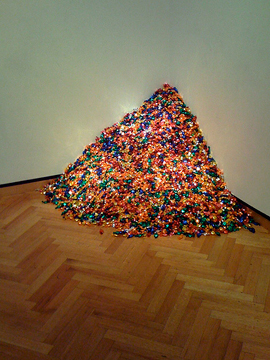
It might seem a bit old-fashioned to bemoan the demise of the portrait tradition in contemporary art, but looking at a new show of Renaissance portraits, and having read a short article on Marlene Dumas describing her as “the anti-portraitist,” I’ve been thinking about how, and if, the portrait tendency persists in art now. The National Gallery exhibition, Renaissance Faces, is a survey of portraits and their functions, from Van Eyck’s Arnolfini Portrait, with its evocation of a specific time and place (“Van Eyck Was Here” is scrawled in florid cursive on the back wall of the painting’s room, above the artist’s reflection in a convex mirror) to Raphael’s Pope Julius II, brooding on his political misfortunes, one hand gripping his throne as though fearful of losing it.
What connects these portraits is their ability to reconstitute physical presence through the stuff of paint. Portraiture is less a genre than a function of art itself. Pliny’s legendary origin of painting–the tracing on a cave wall of the projected silhouette of the departing soldier by her weeping lover–is tied into the notion that art can stand in for a physical absence. Both the physical and the visual–the temporal as well as spatial–presence is implied in the meticulousness of the painted portrait, a meticulousness bound up in the shortness of life expectancy in the Renaissance and the function of portraits as diplomatic tokens. What came persistently to mind while looking at the show was Dave Hickey’s passage in Air Guitar about Scott Burton. Hickey attempts to recall his late friend’s presence through images, and comes to this fascinating conclusion:
“I could have…looked at a photograph, of course, but photographs are nailed in the moment of their making, and when the subject is dead, this distance from the present only reminds you of that. I would have preferred an image that reminded me, persuasively, physically, that Scott had once been alive…That’s what painting used to do – what only painting can do – and does no longer, and this seemed a pity, since regardless of fashions in image-making, we continue to die at an alarming rate.”
A portrait is the visualization of presence, not of likeness, and while the rather conservative likeness tradition continues apace, and while there are artists (like Elizabeth Peyton, Dumas, and Luc Tuymans) who engage with the tradition to a certain extent, they present the image as image, not as a conceptualization of presence and absence. Lucian Freud’s muscular impasto portraits perpetuate the tradition of the great 17th-century portraitists (Velazquez, Rubens, and Rembrandt), but are locked into a groove of representation that is resolutely ahistorical.
Perhaps the closest contemporary art has got to the fundamentals of portraiture is in the work of Felix Gonzalez-Torres. His 1991 Portrait of Ross in LA is, ostensibly, a pile of brightly wrapped candies piled in the corner of the gallery, to which viewers can help themselves. Replenished daily by the gallery, the candy stack weighs 175lbs, the weight at full health of Gonzalez-Torres’ deceased lover, Ross. What this work has in common with the tradition of the painted portrait is in its realization of the intertwining of the physical and visual that characterizes our experiences of other people. It’s a condition of the persistence of an idea (a sort of post-Warhol slippage between subject and form) that this function has been sidelined in contemporary art practice. It’s what sends a shot up your spine when you see Van Eyck reflected in the mirror, or consider that the painter “was here,” exactly where you stand as you read it, or feel the sweetness in your mouth long after you’ve left the gallery.